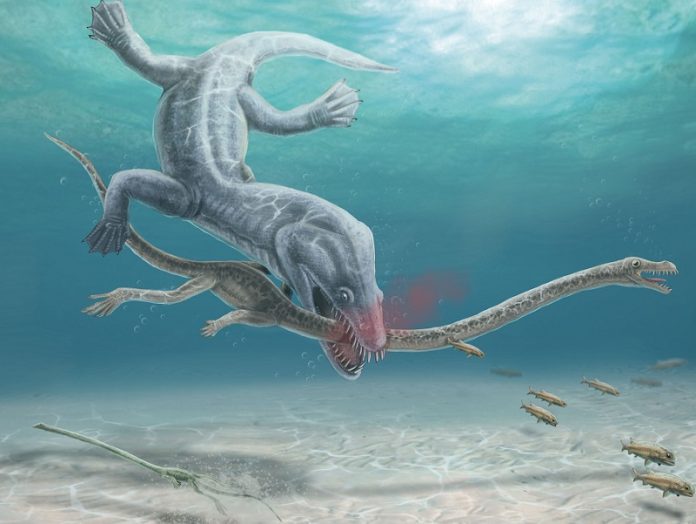
Long-necked reptiles that roamed the Earth during the time of dinosaurs have left behind a fascinating story in their fossilized remains.
Recent research has uncovered evidence confirming a shocking fate for these marine creatures: their predators decapitated them.
The study sheds light on the vulnerabilities and risks associated with evolving long necks while highlighting the success and endurance of these remarkable reptiles.
Scientists have focused their attention on two species of ancient reptiles known as Tanystropheus, which lived around 240 million years ago during the Triassic period.
These reptiles had unique necks consisting of 13 elongated vertebrae and sturdy ribs, indicating that they possessed stiffened necks, enabling them to lie in wait for their prey.
However, it appears that their predators cleverly exploited the very feature that made them successful hunters.
Careful analysis of fossilized bones revealed bite marks on the necks of two Tanystropheus specimens representing different species. Remarkably, in one case, the bite marks were precisely where the neck was broken.
This gruesome finding provides rare evidence of predator-prey interactions from over 240 million years ago, shedding light on the ancient world of marine reptiles.
Stephan Spiekman from the Staatliches Museum für Naturkunde Stuttgart, Germany, and Eudald Mujal from the Institut Català de Paleontologia Miquel Crusafont, Spain, collaborated on the study.
They examined the two specimens housed at the Paleontological Museum of the University of Zurich, Switzerland, and confirmed that the necks had been bitten off.
A Startling Discovery
The researchers were struck by the undisturbed preservation of the skull and portion of the neck, suggesting that the bones were covered by soft tissues like muscle and skin when they were buried.
These finding hints that the predators were likely less interested in the slender necks and small heads, focusing instead on the more substantial body parts.
The evidence suggests that both individuals were decapitated during hunting events rather than being scavenged.
The study reinforces earlier theories that the long necks of these ancient reptiles were a distinct evolutionary adaptation, narrower and stiffer than those of other long-necked marine reptiles.
While there were risks associated with having a long neck, the advantages clearly outweighed them.
This unique trait persisted for 175 million years, appearing in various marine reptile species and spanning different regions of the world.
The research underscores the concept of trade-offs in evolution, where certain advantages come with inherent risks.
The long-necked reptiles exemplify this delicate balance, showcasing the benefits and downsides of a specialized physical feature. Despite the dangers they faced, Tanystropheus thrived for millions of years, leaving their mark on multiple continents.
The discovery of decapitated long-necked reptiles reveals a gruesome chapter from Earth’s ancient past. These reptiles, with their remarkably elongated necks, were both formidable predators and vulnerable prey.
The study offers valuable insights into the intricate workings of evolution, reminding us that nature’s adaptations involve complex trade-offs. The enduring success of Tanystropheus in the face of predatory risks demonstrates the remarkable resilience of life throughout Earth’s history.
The study was published in the journal Current Biology.



